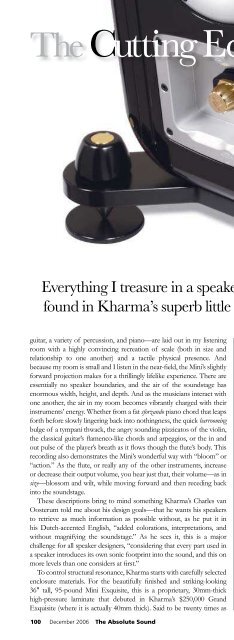You also want an ePaper? Increase the reach of your titles
YUMPU automatically turns print PDFs into web optimized ePapers that Google loves.
The Cutting Edge<br />
Everything I treasure in a speaker can be<br />
found in Kharma’s superb little package<br />
guitar, a variety of percussion, and piano—are laid out in my listening<br />
room with a highly convincing recreation of scale (both in size and<br />
relationship to one another) and a tactile physical presence. And<br />
because my room is small and I listen in the near-field, the Mini’s slightly<br />
forward projection makes for a thrillingly lifelike experience. There are<br />
essentially no speaker boundaries, and the air of the soundstage has<br />
enormous width, height, and depth. And as the musicians interact with<br />
one another, the air in my room becomes vibrantly charged with their<br />
instruments’ energy. Whether from a fat sforzando piano chord that leaps<br />
forth before slowly lingering back into nothingness, the quick barrooming<br />
bulge of a tympani thwack, the angry sounding pizzicatos of the violin,<br />
the classical guitar’s flamenco-like chords and arpeggios, or the in and<br />
out pulse of the player’s breath as it flows though the flute’s body. This<br />
recording also demonstrates the Mini’s wonderful way with “bloom” or<br />
“action.” As the flute, or really any of the other instruments, increase<br />
or decrease their output volume, you hear just that, their volume—as in<br />
size—blossom and wilt, while moving forward and then receding back<br />
into the soundstage.<br />
These descriptions bring to mind something Kharma’s Charles van<br />
Oosterum told me about his design goals—that he wants his speakers<br />
to retrieve as much information as possible without, as he put it in<br />
his Dutch-accented English, “added colorations, interpretations, and<br />
without magnifying the soundstage.” As he sees it, this is a major<br />
challenge for all speaker designers, “considering that every part used in<br />
a speaker introduces its own sonic footprint into the sound, and this on<br />
more levels than one considers at first.”<br />
To control structural resonance, Kharma starts with carefully selected<br />
enclosure materials. For the beautifully finished and striking-looking<br />
36" tall, 95-pound Mini Exquisite, this is a proprietary, 30mm-thick<br />
high-pressure laminate that debuted in Kharma’s $250,000 Grand<br />
Exquisite (where it is actually 40mm thick). Said to be twenty times as<br />
costly as MDF, this material offers just what van Oosterum seeks in his<br />
enclosures—an ideal combination of rigidity and internal damping. The<br />
diamond tweeter is housed in its own chamber, and substantial internal<br />
bracing and internal diffusers are built into the Mini’s entire structure. A<br />
cast and round-lipped aluminum vent is fitted into the rear-firing port<br />
found just above Kharma’s custom binding-post station, and a heavyduty<br />
base structure bolts to the enclosure’s bottom panel, into which<br />
large and pointy feet are threaded. These in turn sit on protective and<br />
non-resonant discs, whether the speaker rests on carpet or hardwood.<br />
Speaking of diamonds, while several top speaker makers are using<br />
diamond tweeters for their extreme rigidity and lightness, Kharma is<br />
among the few to use a 25mm (one-inch) dome rather than the much<br />
more common 19mm (.75-inch) variety. Van Oosterum tells me that the<br />
diamond is made in a microwave plasma reactor in accordance with the<br />
poly-diamond-deposition method, in which the reactor is loaded with<br />
gas and the diamond is deposited on a mold to create the desired shape.<br />
The thickness of the diamond is directly related to its time in the plasma<br />
reactor, and it takes an enormous amount of energy for the diamond<br />
to reach its ideal thickness, which in this case is 60 microns—or thinner<br />
than a sheet of paper. Kharma’s U.S. importer Bill Parish of GTT Audio<br />
added that, in addition to its 25mm inverted diamond-dome, each of<br />
the Exquisite tweeter’s remaining parts—from wires to magnets to voice<br />
coil—are made exclusively for Kharma and final assembly is done inhouse.<br />
As you might imagine, such tweeters are both extremely delicate<br />
(a protective removable screen is part of the kit) and costly items—<br />
roughly the same price as a case of first-growth Bordeaux.<br />
Similarly pricey (if not nearly as) and just as fragile is the 7" ceramic<br />
bass/midrange driver. Protected by a mesh grille to keep it, too, from<br />
ending up like Humpty-Dumpty’s shell, the ceramic mid/bass driver in<br />
the Exquisite series differs from most others, including those in other<br />
Kharma models, such as the terrific little Ceramique 3.2 that had been<br />
100 December 2006 The Absolute Sound










